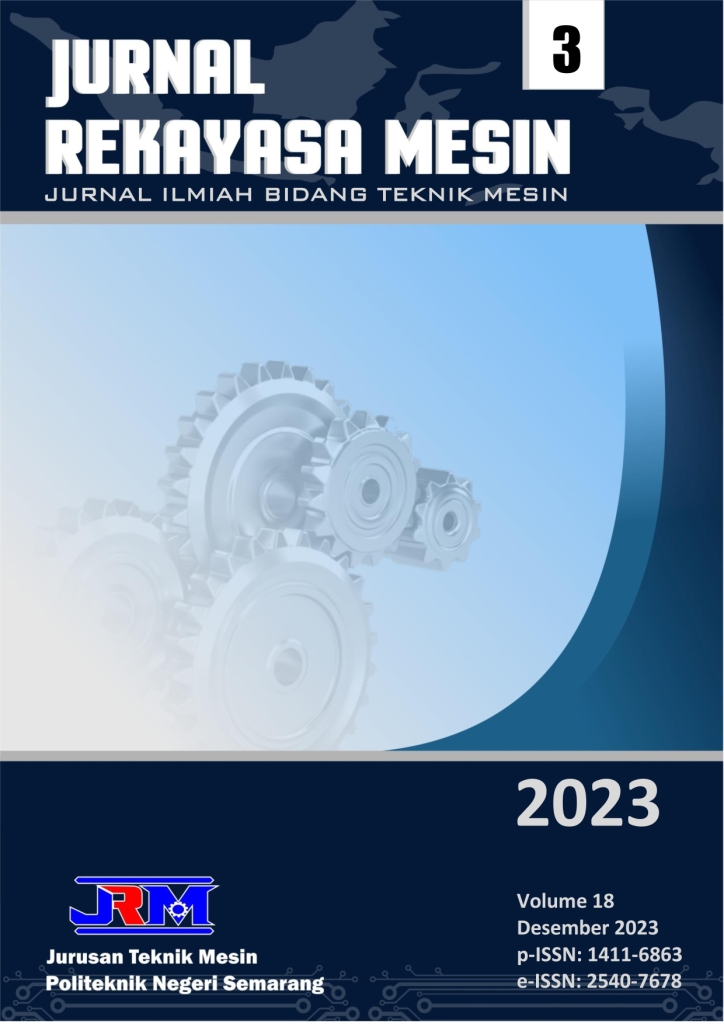Experimental and Numerical Study of Shock Absorber Characterization and The Implication on The Dynamics of Half Vehicle Suspension System Model
DOI:
https://doi.org/10.32497/jrm.v18i3.5023Keywords:
damping ratio, displacement, ride comfort, shock absorber, vehicle dynamicsAbstract
This study aimed to characterized shock absorber damping for passenger comfort. The riding comfort of the vehicle has direct correlation to the damping characteristic of the shock absorber of the suspension system. Two different shock absorbers were experimentally evaluated, and their damping characteristics were integrated into a half-car model to study the vehicle's dynamic response to harmonic road disturbances. The investigation involved numerical simulations of the half-car model subjected to harmonic road disturbances, represented by a set of ordinary differential equations solved using the Dormand-Prince method. Experimental data yielded average damping forces of 502.77 N for shock-absorber #1 and 192.03 N for shock-absorber #2. Calculations resulted in damping coefficients of 3888.57 N ·s/m for shock-absorber #1 and 1397.85 N ·s/m for shock-absorber #2, with corresponding damping ratios of 0.29 and 0.105. These damping ratios generally aligned with typical values for passenger car shock absorbers, except for shock-absorber #2, which deviated from the expected range. The study found that at 60 km/h and 90 km/h, shock-absorber #1 with ζ=0.29 exhibited superior performance in reducing displacement amplitude compared to shock-absorber #2 at ζ=0.105. However, at 120 km/h, both shock-absorbers displayed similar responses, with shock-absorber #1 slightly surpassing shock-absorber #2 in displacement amplitude.References
A. An-Nizhami, N. Apriandi, P. Yanuar, and W. I. Nugroho, “Pemodelan Sistem Suspensi Pasif dan Semi Aktif Regeneratif dengan Model Half Car dan Eksitasi Harmonik,” 2022.
M. Silveira, B. R. Pontes, and J. M. Balthazar, “Use of nonlinear asymmetrical shock absorber to improve comfort on passenger vehicles,” J Sound Vib, vol. 333, no. 7, pp. 2114”“2129, Mar. 2014, doi: 10.1016/j.jsv.2013.12.001.
Q. H. Nguyen, S. B. Choi, and Y. G. Park, “An analytical approach to optimally design of electrorheological fluid damper for vehicle suspension system,” Meccanica, vol. 47, no. 7, pp. 1633”“1647, Oct. 2012, doi: 10.1007/s11012-012-9544-3.
J. O. Pedro, S. M. S. Nhlapo, and L. J. Mpanza, “Model Predictive Control of Half-Car Active Suspension Systems Using Particle Swarm Optimisation,” IFAC-PapersOnLine, vol. 53, no. 2, pp. 14438”“14443, Jan. 2020, doi: 10.1016/J.IFACOL.2020.12.1443.
G. Wang, C. Chen, and S. Yu, “Optimization and static output-feedback control for half-car active suspensions with constrained information,” J Sound Vib, vol. 378, pp. 1”“13, Sep. 2016, doi: 10.1016/J.JSV.2016.05.033.
C. Hua, J. Chen, Y. Li, and L. Li, “Adaptive prescribed performance control of half-car active suspension system with unknown dead-zone input,” Mech Syst Signal Process, vol. 111, pp. 135”“148, Oct. 2018, doi: 10.1016/J.YMSSP.2018.03.048.
C. Onat, I. B. Kucukdemiral, S. Sivrioglu, I. Yuksek, and G. Cansever, “LPV gain-scheduling controller design for a non-linear quarter-vehicle active suspension system,” Transactions of the Institute of Measurement & Control, vol. 31, no. 1, pp. 71”“95, 2009, doi: 10.1177/0142331208090630.
N. Zulkarnain, H. Zamzuri, and S. A. Mazlan, “RIDE AND HANDLING ANALYSIS FOR AN ACTIVE ANTI-ROLL BAR: CASE STUDY ON COMPOSITE NONLINEAR CONTROL STRATEGY,” International Journal of Automotive and Mechanical Engineering, vol. 10, pp. 2122”“2242, Mar. 2014, doi: 10.15282/ijame.10.2014.28.0179.
K. M. M. Rathai, M. Alamir, and O. Sename, “GPU based Stochastic Parameterized NMPC scheme for Control of Semi-Active Suspension System for Half Car Vehicle,” IFAC-PapersOnLine, vol. 53, no. 2, pp. 14369”“14374, Jan. 2020, doi: 10.1016/J.IFACOL.2020.12.1391.
J. Emura, S. Kakizaki, F. Yamaoka, and M. Nakamura, “Development of the Semi-Active Suspension System Based on the Sky-Hook Damper Theory,” SAE Transactions, vol. 103, pp. 1110”“1119, 1994, [Online]. Available: http://www.jstor.org/stable/44611825
K. Xue, T. Nagayama, and B. Zhao, “Road profile estimation and half-car model identification through the automated processing of smartphone data,” Mech Syst Signal Process, vol. 142, p. 106722, Aug. 2020, doi: 10.1016/J.YMSSP.2020.106722.
R. Zhang, L. Zhao, X. Qiu, H. Zhang, and X. Wang, “A comprehensive comparison of the vehicle vibration energy harvesting abilities of the regenerative shock absorbers predicted by the quarter, half and full vehicle suspension system models,” Appl Energy, vol. 272, p. 115180, Aug. 2020, doi: 10.1016/J.APENERGY.2020.115180.
J. Wu and Z. Liu, “Piecewise Affine H∞ Control of Half-Car Magneto-Rheological Suspension Systems,” IFAC-PapersOnLine, vol. 51, no. 31, pp. 967”“972, Jan. 2018, doi: 10.1016/J.IFACOL.2018.10.055.
P. Gandhi, S. Adarsh, and K. I. Ramachandran, “Performance Analysis of Half Car Suspension Model with 4 DOF using PID, LQR, FUZZY and ANFIS Controllers,” Procedia Comput Sci, vol. 115, pp. 2”“13, Jan. 2017, doi: 10.1016/J.PROCS.2017.09.070.
J. R. Dormand and P. J. Prince, “A family of embedded Runge-Kutta formulae,” J Comput Appl Math, vol. 6, no. 1, pp. 19”“26, Mar. 1980, doi: 10.1016/0771-050X(80)90013-3.
S. S. Rao, Mechanical vibrations. Prentice Hall, 2011.
J. A. Calvo, V. DÃaz, and J. L. San Román, “Establishing inspection criteria to verify the dynamic behaviour of the vehicle suspension system by a platform vibrating test bench,” International Journal of Vehicle Design, vol. 38, no. 4, pp. 290”“306, 2005, doi: 10.1504/IJVD.2005.007623.






